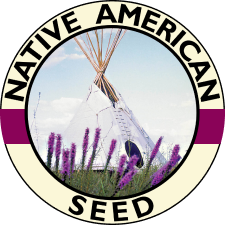Shade loving, perennial grass with wide leaves. Grows 2 to 3 ft high. Distinct and attractive chevron seedheads. Often found thriving along creeks and river banks in woodland areas. Highly palatable to livestock, but can be easily grazed out. This is one of just a very few Native Grasses that thrive in shady and moist conditions. It is also salt tolerant and can prove useful in dune management where sunlight is not too intense.
The Natives are Friendly
Inland Sea Oats is an exceptional grass that can be planted even in the deepest shade. It is most valued for its ornamental seed heads and its ability to quickly vegetate critically eroding shady areas such as stream beds. This is the perfect grass for erosion control in these areas and it is one of the few grasses that can grow aggressively in these conditions as well as improve water quality. Inland Sea Oats has been proven to be salt tolerant and has been used for many years along the coast to help manage sand dunes. With the abundant moisture in the coastal climate I have seen the seed heads grow 4 to 5ft high with the individual spikelets, hanging from threadlike stems sometimes, 3 to 4 inches long. The more moisture it has the more sunlight it can tolerate. The seed heads make beautiful dried arrangements. If left uncut on the plant, they will turn a yellowish bronze color after exposure to the cold, adding interest to the winter landscape. In the home landscape you should try adding this grass as an accent around your ponds, the shady parts next to the house where nothing will grow, around the base of your big trees where the sun rarely reaches or in a large pot on a patio or porch.
Inland Sea Oats will normally grow anywhere from 1ft up to 4ft high and spread aggressively if planted in shady moist conditions. This is a perennial clump or bunch grass with rhizomatous roots. The leaves are blue-green in deeper shade and a lighter yellow-gold in sunnier spots. Livestock readily graze it but because of its preference for growing on stream banks where cattle have restricted access, its forage value is limited. Its native range is from Pennsylvania south to Florida and west to Arizona. Wildlife depend on Inland Sea Oats mainly for the habitat it provides in helping stabilize highly erodible areas, but also for food and nesting material. For the butterfly enthusiast, Inland Sea Oats is a larval host for the Pepper & Salt skipper butterfly, Bells roadside skipper butterfly and the Bronzed roadside skipper butterfly. Inland Sea Oats will be at home in any shady moist setting, be it rural or urban.
INLAND SEAOATS
Chasmanthium latifolium
- Item: #
- 2013
1 Ft - 3 Ft Height
|Perennial
|Blooms Jun - Sep
Soil Type
Sand
Loam
Clay
Caliche
Soil Moisture
Medium Soil Moisture
Moist Soil
Sunlight
Full
Partial
Dappled
Shade
Seed
Rate
What's the Seeding Rate?
**LAWN & GARDEN: High density rate improves fill and establishment while reducing weed opportunity **OPEN SPACE: Economical rangeland density for larger acreage but requires longer establishment period
Lawn & Garden:
1 LB covers 1500 sq ft
Open Space:
12 LB per acre
Write a Review













